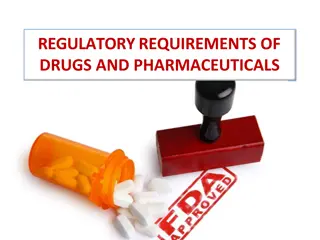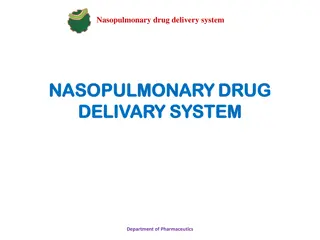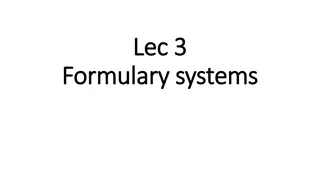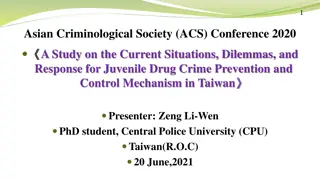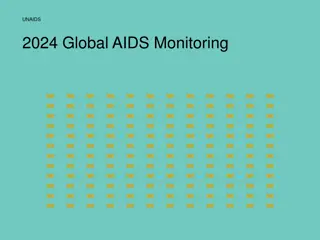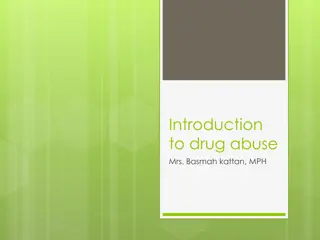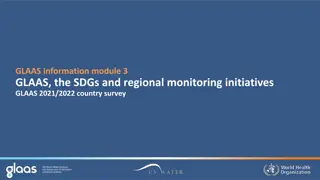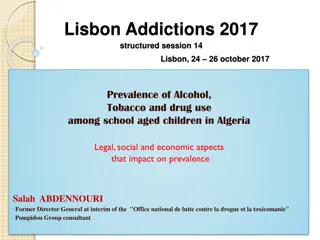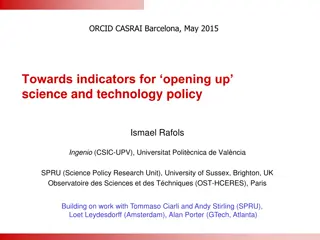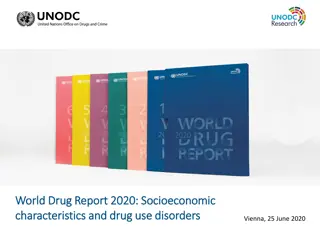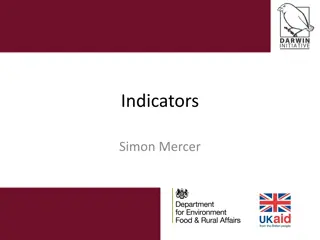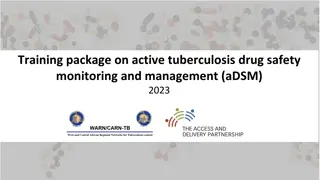Global Epidemiology of Drug Use: Indicators and Challenges
This presentation by Chlo Carpentier discusses the global epidemiology of drug use, focusing on indicators and challenges. It sheds light on the patterns, trends, and impacts of drug use worldwide, emphasizing the importance of epidemiology in addressing drug demand reduction efforts. The session covers key insights and considerations for developing effective strategies to combat drug abuse on a global scale.
Download Presentation

Please find below an Image/Link to download the presentation.
The content on the website is provided AS IS for your information and personal use only. It may not be sold, licensed, or shared on other websites without obtaining consent from the author.If you encounter any issues during the download, it is possible that the publisher has removed the file from their server.
You are allowed to download the files provided on this website for personal or commercial use, subject to the condition that they are used lawfully. All files are the property of their respective owners.
The content on the website is provided AS IS for your information and personal use only. It may not be sold, licensed, or shared on other websites without obtaining consent from the author.
E N D
Presentation Transcript
Global epidemiology of drug use: indicators and challenges Chlo Carpentier Drug Research Section, Chief UNODC Virtual Conference on Drug Demand Reduction in Africa, Plenary 4: Epidemiology and its Role in Drug Demand Reduction, 20 October 2020
Why drug use epidemiology? to support evidence-based responses to drug use Develop policies and programmes (interventions) Evaluate the outcome and impact of policies and programmes Allocate resources to priority areas Contribute to international monitoring and policy debate
Why drug use epidemiology? to generate reliable information for policies & programmes Identify existing drug use patterns Type of drugs, by whom, what ways Monitor changing trends in patterns Over time, geographic area and population groups Detecting new drugs, methods of use Determine health and social consequences of drug use
Monitoring the SDGs Goal 3 Goal 3 Ensure healthy lives and promote well being for all at all ages Target 3.5 strengthening the prevention and treatment of substance abuse including narcotic drug abuse Indicator number of people provided drug treatment services / estimates of people with drug use disorder (= in need of treatment)
Key epidemiological indicators of drug use Lisbon consensus, CND 2000 Extent of drug use (prevalence and incidence in the general population youth population) Population/school surveys High risk drug use (e.g. more regular drug users, those injecting drugs, those with drug use disorders) Focused Assessments / indirect estimation methods Treatment demand Drug related morbidity(HIV, HCV, TB, mental health, etc.) Drug related mortality Registers administrative data Registers administrative data
Number of drug users on the rise 2018 269 million people used drugs in the past year or 5.4% of 15-64 35 million people with drug use disorders or 0.7% of 15-64 Number of people who use drugs and people with drug use disorders, 2006 2018 Prevalence of drug use and drug use disorders, 2006 2018
Estimates of global numbers of people using drugs 2018
Cannabis use higher in youth
11.3 million people who inject drugs, one eight living with HIV
Half people who inject drugs are living with hepatitis C And
Increase in cannabis use disorders in people in drug treatment
585,000 drug related deaths, half due to hepatitis C
Drug use: epidemiological indicators and responses Registers treatment, morbidity, mortality Known Aftercare Treatment Harm reduction drug users High risk users Focused assessments (size estimation by indirect methods) Dependent users Screening and brief intervention Drug use disorders Surveys general population schools/youth Current users (past 30 days) Prevention Recent users (past 12 months) Ever used a substance (lifetime)
Emerging drugs and trends in patterns of use Case reporting Emergency room visits Community-based services (outreach, drop-in services) Forensic services Police Treatment services Consumption of drugs Waste water analysis
Drug use among vulnerable populations Population groups that are especially impacted by socioeconomic inequalities resulting from drug use disorders Indigenous populations Immigrants Displaced populations Women Children Sexual minorities Sex workers People in prison Homeless people No international consensus on vulnerable populations neither on how to monitor drug use among these groups
Drug use in prison Any drug 31% at least once 19 % past month
Inter Agency Technical Working Group on Drug Epidemiology IATWG-DE UNODC-WHO led + African Union, EMCDDA, OAS/CICAD For strategic partnerships and better coordination and harmonization of efforts in drug epidemiology, 2016 Identify major gaps and challenges for producing the global & regional/subregional estimates on drug use and its health and social consequences Discuss current approaches, major data gaps and challenges for reporting on SDG target 3.5 Identify key priorities for collaboration Discuss and identify roles and responsibilities of the organizations to address key priorities for international collaboration




